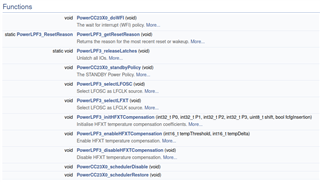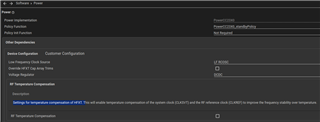Hello
We are using the internal 32 kHz RC Oscillator (LFOSC) as a source for the low frequency system clock (LFCLK).
In the datasheet I read, that the accuracy of the LFCLK - derived Real Time Clock can be improved using the TI-provided power driver.
Could you please help me understand, how this is done?
From the API of the CC2340R5 Power driver
I assumed, that it might be PowerLPF3_initHFXTCompensation / PowerLPF3_enableHFXTCompensation / PowerLPF3_disableHFXTCompensation.
In this case, I could enable the RF Temperature Compensation in the .syscfg file of my project.
But since the function descriptions do not mention any relation to the LFCLK, I suspect this is not correct?
Thank you very much in advance for any help you might be able to provide.


